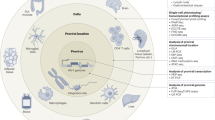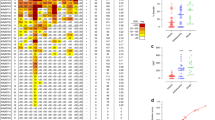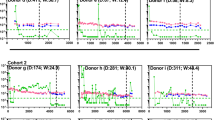Abstract
Increasing evidence indicates that potent anti-HIV-1 activity is mediated by cytotoxic T lymphocytes (CTLs)1,2,3; however, the effects of this immune pressure on viral transmission and evolution have not been determined. Here we investigate mother–child transmission in the setting of human leukocyte antigen (HLA)-B27 expression, selected for analysis because it is associated with prolonged immune containment in adult infection4. In adults, mutations in a dominant and highly conserved B27-restricted Gag CTL epitope lead to loss of recognition and disease progression4,5,6. In mothers expressing HLA-B27 who transmit HIV-1 perinatally, we document transmission of viruses encoding CTL escape variants in this dominant Gag epitope that no longer bind to B27. Their infected infants target an otherwise subdominant B27-restricted epitope and fail to contain HIV replication. These CTL escape variants remain stable without reversion in the absence of the evolutionary pressure that originally selected the mutation. These data suggest that CTL escape mutations in epitopes associated with suppression of viraemia will accumulate as the epidemic progresses, and therefore have important implications for vaccine design.
This is a preview of subscription content, access via your institution
Access options
Subscribe to this journal
Receive 51 print issues and online access
$199.00 per year
only $3.90 per issue
Buy this article
- Purchase on Springer Link
- Instant access to full article PDF
Prices may be subject to local taxes which are calculated during checkout



Similar content being viewed by others
References
Schmitz, J. E. et al. Control of viremia in simian immunodeficiency virus infection by CD8+ lymphocytes. Science 283, 857–860 (1999).
Allen, T. M. et al. Tat-specific cytotoxic T lymphocytes select for SIV escape variants during resolution of primary viraemia. Nature 407, 386–390 (2000).
Rosenberg, E. S. et al. Immune control of HIV-1 after early treatment of acute infection. Nature 407, 523–526 (2000).
Goulder, P. J. et al. Late escape from an immunodominant cytotoxic T-lymphocyte response associated with progression to AIDS. Nature Med. 3, 212–217 (1997).
Kelleher, A. D. et al. Clustered mutations in HIV-1 Gag are consistently required for escape from HLA-B27 restricted CTL responses. J. Exp. Med. 193, 375–386 (2001).
Phillips, R. E. et al. Human immunodeficiency virus genetic variation that can escape cytotoxic T cell recognition. Nature 354, 453–459 (1991).
Wilson, J. D. et al. Direct visualization of HIV-1-specific cytotoxic T lymphocytes during primary infection. Aids 14, 225–233 (2000).
Human Retroviruses and AIDS 1999. A Compilation and Analysis of Nucleic Acid and Amino Acid Sequences (ed Kuiken, C. L.) (Theoretical Biology and Biophysics Group, Los Alamos National Laboratory, Los Alamos, New Mexico 〈http://hiv-web.lanl.gov/HTML/99compendium.html〉), (1999).
Kaslow, R. A. et al. Influence of combinations of human major histocompatibility complex genes on the course of HIV-1 infection. Nature Med. 2, 405–411 (1999).
Barnhart, H. X. et al. Natural history of human immunodeficiency virus disease in perinatally infected children: an analysis from the Pediatric Spectrum of Disease Project. Pediatrics 97, 710–716 (1996).
Guo, H. C. et al. Comparison of the P2 specificity pocket in three human histocompatibility antigens: HLA-A*6801, HLA-A*0201, and HLA-B*2705. Proc. Natl Acad. Sci. USA 90, 8053–8057 (1993).
Nietfield, W. et al. Sequence constraints and recognition by CTL of an HLA-B27-restricted HIV-1 gag epitope. J. Immunol. 154, 2189–2197 (1995).
Altfeld, M. et al. Cellular immune responses and viral diversity in individuals treated during acute and early HIV-1 infection. J. Exp. Med. 193, 169–180 (2001).
Goulder, P. J. et al. Substantial differences in specificity of HIV-specific cytotoxic T cells in acute and chronic HIV infection. J. Exp. Med. 193, 181–194 (2001).
Brander, C. et al. Lack of strong immune selection pressure by the immunodominant, HLA-A*0201-restricted cytotoxic T lymphocyte response in chronic human immunodeficiency virus-1 infection. J. Clin. Invest. 101, 2559–2566 (1998).
Connor, E. M. et al. Reduction of maternal-infant transmission of human immunodeficiency virus type 1 with zidovudine treatment. Pediatric AIDS Clinical Trials Group Protocol 076 Study Group. N. Engl. J. Med. 331, 1173–1180 (1994).
Quinn, T. C. et al. Viral load and heterosexual transmission of human immunodeficiency virus type 1. Rakai Project Study Group. N. Engl. J. Med. 342, 921–929 (2000).
Pantaleo, G. et al. The qualitative nature of the primary immune response to HIV infection is a prognosticator of disease progression independent of the initial level of plasma viremia. Proc. Natl Acad. Sci. USA 94, 254–258 (1997).
Barouch, D. H. et al. Control of viremia and prevention of clinical AIDS in rhesus monkeys by cytokine-augmented DNA vaccination. Science 290, 486–492 (2000).
Moskophidis, D. & Zinkernagel, R. M. Immunobiology of cytotoxic T-cell escape mutants of lymphocytic choriomeningitis virus. J. Virol. 69, 2187–2193 (1995).
Lewicki, H. A., Von Herrath, M. G., Evans, C. F., Whitton, J. L. & Oldstone, M. B. CTL escape viral variants. II. Biologic activity in vivo. Virology 211, 443–450 (1995).
de Campos-Lima, P. O. et al. HLA-A11 epitope loss isolates of Epstein-Barr virus from a highly A11+ population. Science 260, 98–100 (1993).
Ciurea, A., Hunziker, L., Klenerman, P., Hengartner, H. & Zinkernagel, R. Impairment of CD4(+) T cell responses during chronic virus infection prevents neutralizing antibody responses against virus escape mutants. J. Exp. Med. 193, 297–306 (2001).
Bunce, M. et al. Phototyping: comprehensive DNA typing for HLA-A, B, C, DRB1, DRB3, DRB4, DRB5 & DQB1 by PCR with 144 primer mixes utilizing sequence-specific primers (PCR-SSP). Tissue Antigens 46, 355–367 (1995).
Brander, C. & Goulder, P. J. R. in HIV Molecular Immunology Database (eds Korber, B. et al.) (Los Alamos National Laboratory, Los Alamos, New Mexico, 1999).
Goulder, P. J. et al. Differential narrow focusing of immunodominant human immunodeficiency virus gag-specific cytotoxic T-lymphocyte responses in infected African and caucasoid adults and children. J. Virol. 74, 5679–5690 (2000).
Pitcher, C. J. et al. HIV-1-specific CD4+ T cells are detectable in most individuals with active HIV-1 infection, but decline with prolonged viral suppression. Nature Med. 5, 518–525 (1999).
Goulder, P. J. et al. Functionally inert HIV-specific cytotoxic T lymphocytes do not play a major role in chronically infected adults and children. J. Exp. Med. 192, 1819–1832 (2000).
Altfeld, M. A. et al. Identification of dominant optimal HLA-B60- and HLA-B61-restricted cytotoxic T-lymphocyte (CTL) epitopes: rapid characterization of CTL responses by enzyme-linked immunospot assay. J. Virol. 74, 8541–8549 (2000).
Yang, O. O. et al. Suppression of human immunodeficiency virus type 1 replication by CD8+ cells: evidence for HLA class I-restricted triggering of cytolytic and noncytolytic mechanisms. J. Virol. 71, 3120–3128 (1997).
Acknowledgements
We thank those who have facilitated the collection of blood samples for this study, in particular N. Karthas, C. Kneut, S. Theodore and M. Phillips. We also thank J. Mear for help with binding assays, and the Women and Infant Transmission Study (WITS) for access to cryopreserved samples. The work was supported by the Medical Research Council (UK), the NIH, the Doris Duke Charitable Foundation, the Lloyd Foundation, the Elizabeth Glaser Pediatric AIDS Foundation, and a number of private donors. P.J.R.G. is an Elizabeth Glaser Scientist and B.D.W. is a Doris Duke Distinguished Clinical Science Professor.
Author information
Authors and Affiliations
Corresponding author
Supplementary information
Rights and permissions
About this article
Cite this article
Goulder, P., Brander, C., Tang, Y. et al. Evolution and transmission of stable CTL escape mutations in HIV infection. Nature 412, 334–338 (2001). https://doi.org/10.1038/35085576
Received:
Accepted:
Issue Date:
DOI: https://doi.org/10.1038/35085576
This article is cited by
-
More than the Infinite Monkey Theorem: NHP Models in the Development of a Pediatric HIV Cure
Current HIV/AIDS Reports (2024)
-
Rapid assembly of SARS-CoV-2 genomes reveals attenuation of the Omicron BA.1 variant through NSP6
Nature Communications (2023)
-
Exploring the interactions between the human and viral genomes
Human Genetics (2020)
-
Dual HLA B*42 and B*81-reactive T cell receptors recognize more diverse HIV-1 Gag escape variants
Nature Communications (2018)
-
Genetic divergence of HIV-1 B subtype in Italy over the years 2003–2016 and impact on CTL escape prevalence
Scientific Reports (2018)
Comments
By submitting a comment you agree to abide by our Terms and Community Guidelines. If you find something abusive or that does not comply with our terms or guidelines please flag it as inappropriate.



